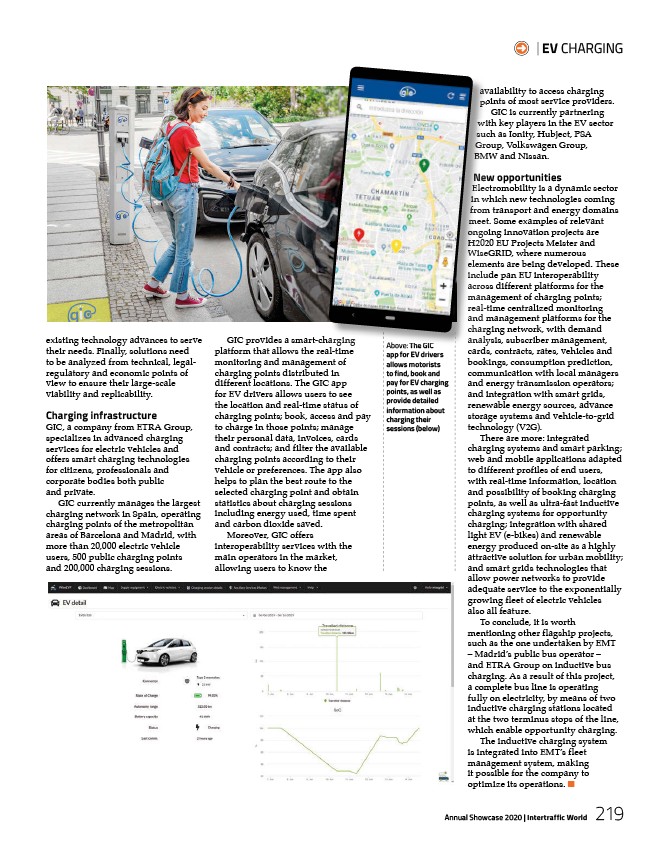
| EV CHARGING
Above: The GIC
app for EV drivers
allows motorists
to find, book and
pay for EV charging
points, as well as
provide detailed
information about
charging their
sessions (below)
Annual Showcase 2020 | Intertraffic World 219
existing technology advances to serve
their needs. Finally, solutions need
to be analyzed from technical, legalregulatory
and economic points of
view to ensure their large-scale
viability and replicability.
Charging infrastructure
GIC, a company from ETRA Group,
specializes in advanced charging
services for electric vehicles and
offers smart charging technologies
for citizens, professionals and
corporate bodies both public
and private.
GIC currently manages the largest
charging network in Spain, operating
charging points of the metropolitan
areas of Barcelona and Madrid, with
more than 20,000 electric vehicle
users, 500 public charging points
and 200,000 charging sessions.
GIC provides a smart-charging
platform that allows the real-time
monitoring and management of
charging points distributed in
different locations. The GIC app
for EV drivers allows users to see
the location and real-time status of
charging points; book, access and pay
to charge in those points; manage
their personal data, invoices, cards
and contracts; and filter the available
charging points according to their
vehicle or preferences. The app also
helps to plan the best route to the
selected charging point and obtain
statistics about charging sessions
including energy used, time spent
and carbon dioxide saved.
Moreover, GIC offers
interoperability services with the
main operators in the market,
allowing users to know the
availability to access charging
points of most service providers.
GIC is currently partnering
with key players in the EV sector
such as Ionity, Hubject, PSA
Group, Volkswagen Group,
BMW and Nissan.
New opportunities
Electromobility is a dynamic sector
in which new technologies coming
from transport and energy domains
meet. Some examples of relevant
ongoing innovation projects are
H2020 EU Projects Meister and
WiseGRID, where numerous
elements are being developed. These
include pan EU interoperability
across different platforms for the
management of charging points;
real-time centralized monitoring
and management platforms for the
charging network, with demand
analysis, subscriber management,
cards, contracts, rates, vehicles and
bookings, consumption prediction,
communication with local managers
and energy transmission operators;
and integration with smart grids,
renewable energy sources, advance
storage systems and vehicle-to-grid
technology (V2G).
There are more: integrated
charging systems and smart parking;
web and mobile applications adapted
to different profiles of end users,
with real-time information, location
and possibility of booking charging
points, as well as ultra-fast inductive
charging systems for opportunity
charging; integration with shared
light EV (e-bikes) and renewable
energy produced on-site as a highly
attractive solution for urban mobility;
and smart grids technologies that
allow power networks to provide
adequate service to the exponentially
growing fleet of electric vehicles
also all feature.
To conclude, it is worth
mentioning other flagship projects,
such as the one undertaken by EMT
– Madrid’s public bus operator –
and ETRA Group on inductive bus
charging. As a result of this project,
a complete bus line is operating
fully on electricity, by means of two
inductive charging stations located
at the two terminus stops of the line,
which enable opportunity charging.
The inductive charging system
is integrated into EMT’s fleet
management system, making
it possible for the company to
optimize its operations. ■